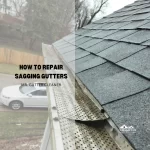Ice dams pose a significant risk to home maintenance, particularly in cold climates where snow and ice accumulate on rooftops. These formations occur when snow melts on a warm roof, then refreezes at the edge, creating a dam that prevents meltwater from draining properly.
This can lead to water seeping under roof shingles, causing damage to roofs, gutters, and even the interior of a home.
Understanding how to safely remove ice dams is crucial for homeowners to prevent costly repairs and maintain the integrity of their homes.
The process involves identifying the presence of ice dams, taking immediate steps to minimize potential damage, and employing safe removal techniques.
Additionally, homeowners must consider long-term prevention strategies, such as improving attic insulation, enhancing ventilation, and sealing air leaks, to mitigate the risk of future ice dams.
Professional services may be necessary for severe cases, underscoring the importance of selecting reliable experts for ice dam removal. This comprehensive approach ensures homeowners are equipped with the knowledge to address and prevent ice dams effectively, safeguarding their homes against the adverse effects of winter weather.
What is an Ice Dam?
An ice dam is a ridge of ice that forms at the edge of a roof and prevents melting snow (water) from draining off the roof. The water that backs up behind the dam can leak into a home and cause damage to walls, ceilings, insulation, and other areas.
How Do Ice Dams Form?
Ice dams form through a cycle of melting and refreezing snow on a roof. Heat from the attic melts snow on the roof, which flows down to the cold edge and refreezes, creating a barrier. Factors such as heavy snowfall and temperature variations across the roof contribute to this process. Inadequate attic insulation and ventilation can exacerbate the formation of ice dams by allowing heat to escape, melting snow unevenly on the roof surface.
Why are Ice Dams a Problem for Homeowners?
Ice dams pose a significant risk to homeowners because the water that backs up behind these dams can leak into the home. This can lead to a host of problems, including mold and mildew growth, damaged insulation, and compromised structural integrity. Additionally, the weight of accumulated ice can strain gutters and roofing materials. Preventing and safely removing ice dams is therefore essential to protect the home from potential water damage and associated repair costs.
Preparing for Ice Dam Removal
Before attempting ice dam removal, it’s crucial for homeowners to prepare adequately to ensure the process is safe and effective. This preparation involves gathering necessary safety equipment and choosing the right time for the removal effort to minimize risks to both the individual and the property.
What Safety Equipment is Needed?
Safety is paramount when removing ice dams. Homeowners should equip themselves with non-slip boots to prevent falls, gloves to protect hands from cold and sharp ice, eye protection from flying ice chips, and a helmet. Using a roof rake for ice removal from the ground is advisable to avoid climbing on a slippery roof. Additionally, having calcium chloride on hand to melt the ice safely without damaging the roofing materials is essential.
When Should You Attempt to Remove an Ice Dam?
Timing the removal of an ice dam is critical. It’s best to tackle the problem on a sunny day when the temperature is slightly above freezing to facilitate the melting process without causing a rapid thaw that could lead to water intrusion. However, if the dam is causing immediate damage, immediate action is necessary regardless of weather conditions. In cases where the dam is extensive or the roof is difficult to access safely, contacting professional ice dam removal services is recommended to avoid personal injury and property damage.
Step 1: Identify the Ice Dam
The first step in safely removing an ice dam is to correctly identify its presence and location on your roof. This involves understanding where ice dams are most likely to form and recognizing the signs that one has developed.
Where to Look for Ice Dams?
Ice dams typically form at the roof’s edge, especially in areas where the roof overhangs the exterior walls. Check around gutters and downspouts, as ice dams often start here and grow larger if left unchecked. Look for large icicles hanging from the eaves; while not all icicles indicate an ice dam, they often accompany them. Additionally, inspect the attic for signs of water intrusion, as this can indicate that an ice dam has formed above.
How to Safely Assess the Ice Dam’s Severity?
Assessing the severity of an ice dam involves looking for water stains or moisture in the attic or along the ceiling and walls of the top floor. Use a ladder to visually inspect the roof edge and gutters, keeping safety in mind. If ice dams are thick and extend several feet up the roof, they’re likely causing water to back up underneath the shingles. It’s crucial to assess the ice dam’s impact carefully to determine the best removal approach and whether professional help is needed.
Step 2: Minimize Damage
Once an ice dam is identified, the immediate goal is to minimize potential damage to the home. This step focuses on actions homeowners can take to prevent water from penetrating the structure while planning for the ice dam’s removal.
Immediate Actions to Prevent Water Intrusion
To prevent water intrusion, homeowners should remove snow from the roof using a roof rake, taking care not to damage the roof’s surface. It’s essential to clear snow about 3 to 4 feet above the ice dam to stop further melting and refreezing. Placing calcium chloride ice melt in a nylon stocking and laying it vertically across the ice dam can help melt a channel in the dam, allowing water to flow off the roof instead of backing up into the home. Avoid using rock salt or other corrosive materials that can damage roofing materials and gutters.
Protecting Your Roof and Gutters
Protecting the roof and gutters involves careful removal techniques to avoid causing more damage. Use a roof rake for snow removal from the ground instead of climbing on the roof, which can be dangerous and potentially cause harm to the roof’s structure. If gutters are clogged with ice, installing heated cables can provide a temporary fix to melt the ice and facilitate water flow. However, these measures are temporary solutions, and addressing the underlying issues causing ice dams is crucial for long-term protection.
Step 3: Removing the Ice Dam
After taking immediate actions to minimize damage, the next step involves the actual removal of the ice dam. This process must be done cautiously to avoid damage to the roof and ensure personal safety.
Safe Ice Removal Techniques
Using a roof rake is the safest method to remove snow and ice from the edge of the roof without the need to climb onto it. For the ice dam itself, applying calcium chloride ice melt products can gently melt the dam without harming roof shingles, unlike rock salt which can cause corrosion. Place the calcium chloride in a nylon stocking and lay it across the ice dam to create melt channels. Another method involves using heated cables or heat tapes along the roof edge and in gutters to prevent ice formation; however, these should be installed before winter.
What Methods to Avoid?
It’s crucial to avoid methods that can damage the roof or pose safety hazards. Do not use sharp tools like axes, picks, or shovels to break up ice dams, as they can tear shingles or puncture the roof. High-pressure hot water sprays can also dislodge roofing materials and are not recommended. Additionally, avoid walking on the roof during winter to prevent falls and further damage to the roof structure. If the situation is beyond safe DIY methods, it’s best to call in professional ice dam removal services.
Step 4: Prevent Future Ice Dams
After addressing immediate ice dam concerns, the focus shifts to preventing future formations. This long-term strategy involves addressing the root causes of ice dams, which stem from heat loss and uneven roof temperatures.
Improving Attic Insulation
Enhancing attic insulation is crucial for maintaining consistent temperatures across the roof’s surface, preventing the melting and refreezing cycle that leads to ice dams.
Homeowners should aim for the recommended insulation level for their geographic area, sealing gaps that allow warm air to escape from the living space into the attic.
This not only prevents ice dams but also improves overall energy efficiency.
Enhancing Ventilation
Proper attic ventilation ensures that any heat that does reach the attic can escape, keeping the roof’s surface at a uniform temperature.
Ventilation options include ridge vents, soffit vents, and powered attic ventilators, which work together to circulate cold air under the entire roof.
Sealing Air Leaks
Air leaks from the living space into the attic are a major contributor to uneven roof temperatures. Sealing these leaks—around light fixtures, chimneys, and attic hatches—helps keep warm air in the living areas and out of the attic. This step, combined with insulation and ventilation improvements, forms a comprehensive approach to ice dam prevention, safeguarding the home against future winter weather challenges.
Professional Ice Dam Removal
In some cases, the severity and risk of ice dams necessitate professional intervention. When DIY methods are insufficient or unsafe, hiring a professional ice dam removal service ensures the job is done safely and effectively.
When to Call a Professional?
Homeowners should consider professional ice dam removal when the dam is extensive, access to the roof is dangerous, or when previous attempts to remove the dam have been unsuccessful. Signs that professional help is needed include large ice formations that persist despite using safe melting products, water leakage into the home, or the inability to safely reach the dam with a roof rake. Professionals have the experience, equipment, and techniques to remove ice dams without damaging the roof.
Selecting a Reliable Ice Dam Removal Service
Choosing a reliable service requires careful consideration. Look for companies with specific experience in ice dam removal, positive customer reviews, and proper insurance to protect against potential damages. Ask about their removal methods to ensure they avoid harmful practices, such as using sharp tools or high-pressure hot water. A reputable service will assess the situation, explain the process, and provide a clear estimate before starting work. Opting for a professional with a track record of success ensures that the ice dam is removed efficiently, minimizing the risk of damage to the home.
FAQs on Ice Dam Removal
Addressing common questions can help homeowners better understand ice dam removal and prevention. This section aims to provide clear, concise answers to frequently asked queries.
Can Ice Dams Cause Permanent Damage?
Yes, ice dams can cause permanent damage if not addressed promptly. Water backed up behind an ice dam can infiltrate under shingles, leading to roof damage, interior water damage, mold, and mildew growth. The weight of ice dams can also strain gutters and roofing structures. Preventing ice dams or removing them safely when they occur is crucial to avoiding long-term damage to your home.
How Often Should I Check for Ice Dams?
Homeowners should inspect their roofs and gutters for signs of ice dams throughout the winter, especially after heavy snowfall or during cycles of freezing and thawing temperatures. Regular checks enable early detection, simplifying removal and minimizing potential damage.
Are Chemical Melts Safe for My Roof?
Not all chemical melts are safe for roofs. While calcium chloride is generally safe and effective for melting ice without damaging asphalt shingles, rock salt (sodium chloride) and other harsh chemicals can corrode metal gutters and downspouts, damage landscaping, and potentially harm roofing materials. Always choose products labeled as safe for roofs and follow the manufacturer’s instructions carefully.


